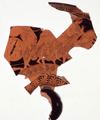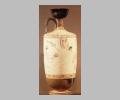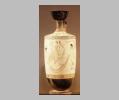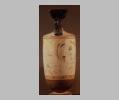Early Middle or Transitional Period: "Rich" Style
A cup in Vienna is an example of Douris' Transitional "rich" style at its best (
Vienna 3695;
;
;
;
ARV2, 429, 26). The three pictures depict episodes involving the arms of Achilles: on the exterior, the quarrel of Ajax and Odysseus on side A, and the vote with Athena presiding on side B. The identity of the figures in the tondo is not certain, but it must be Odysseus presenting the arms of Achilles to Neoptolemos. The young Neoptolemos has a more compact and unified body than the loose-limbed warriors of the Early Period. His hands and feet are smaller, and his proportions are more natural. The neck is not so long and the head is set more realistically without seeming to strain forward. The faces too show more unity. Douris no longer drew each feature separately and painstakingly; greater ease is apparent. The characteristic Dourian facial type has a turned-down mouth, long nose and heavy chin. Douris now used dilute glaze to suggest differing textures; on Neoptolemos he uses it to suggest the light fuzz of a young man's beard in front of the ears.
The scenes on the exterior have many figures but the compositions are strongly centralized; the action is clear, the scenes easily read. Some of the eagerness and vitality of the earlier scenes is gone, but it is replaced with a masterly ability to tell a story.
The story of Ajax and the armor of Achilles is told by other late archaic vase painters, notably the Brygos Painter and Makron (Brygos Painter:
London E 69,
ARV2, 369, 2;
Malibu 86.AE.286:
;
;
;
; Makron:
Louvre C 11271,
ARV2, 460, 12;
Athens, Acr. 315,
ARV2, 459, 11).
1 Douris' Vienna cup is by far the most subtle in using composition, gesture and pose to convey the terrible story. On the side with the quarrel, Agamemnon, standing behind the disputed armor, forms a strong central vertical, his stance and position conveying the steadfastness of the decision against which Ajax vainly protest (
). The movement of the Achaean warriors, three on each side of Agamemnon, leads the eye toward the center. Douris heightens the dramatic tension by placing the antagonists directly opposite each other, kept apart by the iron will of Agamemnon and the restraining hands of their companions. The arm gestures of the three central figures are used compositionally to suggest the conflict.
On the other side, attention is centered on Athena who stands behind the voting block and gestures to the winner, Odysseus, who raises his hands in covetous glee while Ajax, on the far right, cradles his veiled head in sorrow and shame (
). Their emotions reflect the results of the voting in which the other figures take part, the number of votes clearly higher on Odysseus' side. Odysseus and Ajax thus frame the scene both visually and literally, and the direction of the picture flows outward from Athena toward them.
A related composition, only partly preserved, is on the interior of a phiale in Malibu (
Malibu 81.AE.213;
) which shows running figures, a combat, and an assembly of deities. The subject is difficult to interpret. Martin Robertson has assessed the evidence and suggests that the scenes represent episodes loosely linked with the Trojan royal house, Ganymede pursued, Ganymede received by the assembled deities, and Achilles fighting Hector, the two stories providing a contrast between a transformation that led to immortality for Ganymede, and the stark death of Hector. The exterior scenes of two episodes from the story of Eurytos carry on the theme of death and survival, contrasting Herakles with Eurytos and his sons.
2
A white lekythos in Malibu belongs to this same period (
Malibu 84.AE.770;
;
;
;
;
;
;
). Two youths arm, attended by a woman with a shield (device: quatrefoil) and spear, and a boy with a sword and spear. The figures reflect the influence of a major artistic personality of the period, the Kleophrades Painter, whose athletes also have loose-limbed but sturdily constructed bodies, square-shaped heads with strong chins and thick lips (compare for example a calyx-krater in
Tarquinia RC 4196;
ARV2, 185, 35).
A less common subject occurs on a white lekythos in Cleveland (
Cleveland 66.114;
;
;
;
): Atalante running from Erotes. John Boardman has proposed that Atalante, whose dislike of men is a constant theme in literature from Hesiod on, is fleeing from marriage.
3 Her running pose probably alludes to the footrace which she and her suitors engaged in and which she always won, thereby allowing her to kill the suitor who had challenged her. The garland held by one Eros would be a symbol of the marriage Atalante flees; the whip held by the other suggests that such a reluctant bride would have to be beaten into submission. Atalante's rejection of men and her desire for chastity is linked with her dedication to Artemis.
Douris experimented with an unusual decorative scheme during this time. Five cups of the Transitional "rich" period have a figured zone around the tondo; two of them seem to be a pair, both in Berlin (
Berlin F 2283 and
Berlin F 2284;
ARV2, 429, 21-22); and three others are in Malibu (
Malibu 87.AE.11;
Malibu 87.AE.45;
Malibu 90.AE.36). Figured zones are known in Attic black-figure but are not common on red-figure cups of the early fifth century. Contemporaries of Douris who also decorated zoned cups are the Triptolemos and Kleophrades Painters, and since Kleophrades the potter signed the foot of one of Douris' Berlin cups, it is possible that the scheme was connected to him.









































